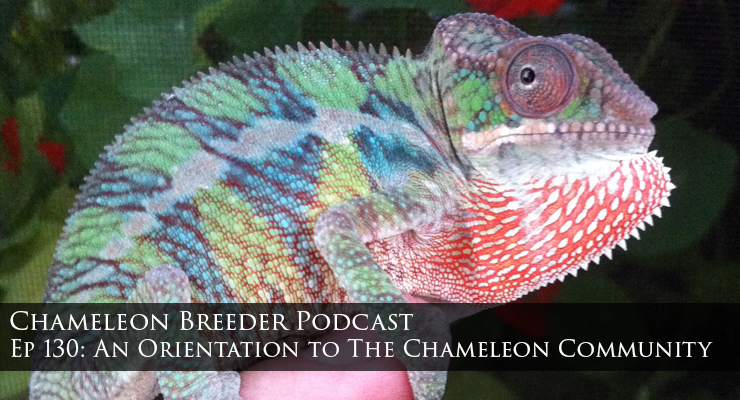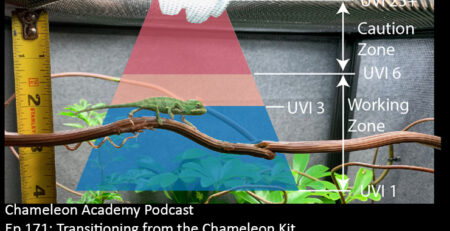Ep 130: An Orientation To The Chameleon Community
Listen Here!
Bill Strand
Ep 130: Introduction to the Chameleon Community
A warm welcome to the new members of our community. In this podcast episode I will be your introduction to the chameleon world. And for those of you who have been around for a while and have travelled with me for all these episodes it is time for us to take a step back and remember what it was like when we first came to the community. The experience can be jarring! And it is healthy for all of us to see through the eyes of a newcomer. But for the rest of this episode, I am talking to the person who has just joined our community.
Transcript (More or Less)
You will find the chameleon community wide spread across all of the social media apps. Some stronger than others, but we are well represented. And, more than likely, this is how you join the community. There is a surprising number of people off the grid, so to speak, but they really aren’t part of the community that will overlap with you – at least for a while!
Social Media orientation
The first thing I want to do is address the reaction you may have gotten when you jumped onto your first Facebook group to show off your new chameleon that you are so proud of, ask for wisdom from the people who have chameleons already, and…. it is like a bomb went off in your hands. Wrong cage, wrong vines, wrong lighting, wrong supplementation, stop cuddling Pascal, why didn’t you do your research?
What in the world happened here?!?! What the heck is Anthropomorphizing? And what could be wrong with my set-up? I did everything the pet store person told me to do! And I know it is right because the kit I spent all that money on had a chameleon on the box. And who are all these keyboard warriors that think they have the right to judge me! The pet store said to watch out for all the trash advice on the internet and I guess this is what they were talking about!
Okay…let’s take a step back. If this was not your experience then I am glad your introduction to our community was a bit more civilized! But there is an unfortunate pattern that plays itself out over and over with new keepers and I’d like to address this directly up front.
It can be a jarring experience going from pet store or reptile show purchase to an online community. The problem is based on the fact that chameleon care is not easy or cheap, but that chameleons have enormous impulse buy potential. So capitalism being what it is, pet stores were hungry for a way to send customers home with their first chameleon with as cheap of a set-up as possible. The problem was that if you bundled an adult cage with all the appropriate equipment the price of that bundle would destroy your impulse buy market. So, instead of saying, hmmm, chameleons are incredibly cool, but are not suited for our target demographic, they created a product bundle that would keep the chameleon alive beyond the return period. And then they train the staff to sell the product and the chameleon. And you are trusting the pet store employee to tell you what you need to know. I have run into some pet store employees that were incredible and some that were completely incompetent. The problem is that if you are totally new to chameleons, you can’t tell the difference. They both talk with the same confidence level. So you spend a lot of money based on their advice, go home, and set up a small cage with a vine and a spring of plastic plant. Wow, that was easy! Oh my gosh, this chameleon loves me, he can’t wait to get out and play with me! This is so awesome! I can’t wait to make friends with other chameleon people!
And thus we are caught up with a decidedly poor social media experience. In groups that have thousands of members there will be a section of that population that will love to beat anyone up they can just to feel like they know something. In the more established groups, the moderator team will bang heads around and force people to act with respect. But if you post when the team is asleep, the rats will be out and there will be an unsavory situation until order is brought in.
If this was your experience, you were probably told your entire set-up needed to be replaced and that you should have done your research before getting a chameleon. Isn’t self-righteous judgement such a wonderful part of human personality? The fact is, you did your research. You talked to a person in a pet store uniform and you bought everything they told you to. There was no trying to be cheap. You literally were willing to do whatever it took to set up your new little friend!
Now here comes the confusion. What is right and why should you listen to all these new names on the internet?
Well, as one of those people on the internet trying to help new chameleon keepers I’ll explain. I always try to present both sides of a situation so people can make educated decisions for themselves. In this case there really isn’t much in the way of two sides. I’ll try and say this as gently as possible, but it is true that very few pet stores and, unfortunately, very few reptile stores will send you home with a correct chameleon set-up and education. And we know this because every day we have people joining our groups with various versions of poor advice. We are lucky when people come before their chameleon is sick because we can prevent the chameleon from getting sick. This is the hardest time for you to learn about what chameleons really need because you don’t yet see a problem. The people that are asking about why their chameleon is sick and dying are much more open to listening! But, that is when it is too late. And so, we see this day in and day out. Your situation is common. Stick around and within a couple days you’ll see people coming in with the exact same situation. It is an epidemic. Ideally, pet stores would give good advice, but the real danger is that they do not realize how bad the advice and products are that they are selling. So they do not know to tell you to do further research. And so, with the confidence of the care pamphlet why would you think you need more to learn? It isn’t until your chameleon is showing signs of illness you are given even a hint that you should check around and see what is wrong.
And we see this all the time as well. Heartbreak. Heartbreak from keepers that did everything they were told and are fully willing to do anything else it takes as far as money and set-up to keep their chameleon happy. And it isn’t until they check around about their chameleon not being able to hold itself up on its branch do they learn that their chameleon has an advanced stage of deadly metabolic bone disease that was completely preventable if they had the right light or proper supplements. And education now does not make up for a year of damage. Yes, we experienced keepers can spot the beginnings of MBD before it does permanent damage, but if this is your first chameleon there is no way you can know what trouble looks like until it is in its advanced stages.
Those of us on the frontlines of general chameleon social media or forum groups see this all the time. We have to correct and console. Some people on these groups are gentle and some people are just plain jerks.
So what now? Well, if you are listening to this podcast then you have decided to push through that initial experience and dig deeper. Obviously, there is a lot to learn and there is an entire library of podcast episodes you can use to fill in whatever topics you want. But I am going to give you a crash course right now to try and focus your energies in the right direction while you make heads and tails of this community.
First of all, Chameleon health. I am going to assume you have a veiled, panther, or jackson’s chameleon. This advice applies to most chameleons so as long as they are the same size, all is good. This will be the briefest of overviews just so you know where to dig in. There are entire podcasts on these subjects and respectable members of the community that can help guide you along in execution.
- Cage: You’ll need an appropriately sized cage. If you were sent home with a 16x16x30” cage then that will be good only for the few months your chameleon is a baby. I am sorry that this is only the first piece of inadequate equipment you have been sent home with. We will have a bit of a list here. Generally speaking, get yourself a 24” x 24” x 48” tall screen cage. There are other cage sizes that will work, but this is the most common cage available and it will work for you.
- Cage Interior. You need a layer of live plants for your chameleon to hide in. They can’t be on the ground. They have to be in the top half of the cage. I know this is challenging in a screen cage. I founded the Dragon Strand chameleon caging company and I had to actually invent a product that would allow us to do this because there just isn’t a good way of doing this. The Dragon Ledges screw into the frame so they allow you to mount plants and horizontal branches up where the chameleon needs them. If you don’t go this route then you need to either buy plants that are tall enough to have a lot of leaves in the upper section of the cage or else you can use plant stands to accomplish the same effect with shorter plants. However you do it you absolutely need plant cover for your chameleon to hide in. Not only is this for their sense of security, but we will need to provide UVB for your chameleon and they need to be able to get out of the UVB when they have had enough.
- Here is that UVB and probably the first thing you were told to change. Chameleons need UVB, just like we do, to produce vitamin D3. But, just like we get sunburns, too much UVB will cause problems with your chameleon. This is why we need that plant cover. Currently the best technology is a T5 linear fluorescent bulb. If your kit does not have a T5 linear then get one, but make sure if you are getting a strong UVB bulb that you also are getting that 48” tall (or other appropriate) cage. Putting a strong UVB over a 30” cage is too much. You’ll find so much of this is all connected.
- Supplementation and gutloading. You need calcium powder and a controlled amount of vitamins. This is where you will get a major amount of disagreement in the community. Just go with whatever your mentor has worked out. Worry about the rest of the community later. The reason why there is so much room for disagreement is because there is so little actually known. Since there is so much ambiguity and lack of hard facts it has been easy for people to slip into getting a little too personally invested. Just concentrate on getting one of these methods down and sit out the ridiculous fighting.
Basics of chameleons
And there are a handful of items about chameleons that we need to nip in the bud. The first is:
Cohabitation.This is when you have two chameleons living in the same cage. This is a big one because reptile stores will see the opportunity to sell you two chameleons instead of just one. The bottom line is that you can not keep chameleons together. They will eventual fight and this fighting may not be visible to your eye – especially if they freeze whenever you walk in the room. Once again, there is an entire podcast episode on cohabitation. Jackson’s Chameleons are particularly prone to being victims of this as they are much more subtle in their mannerisms. Just to save you pain and misery, just get separate cages for your chameleons before going online and bragging about your two chameleons in one cage.
And Affection.Here is where I get called cold, heartless, cynical, and, well, realistic. Chameleons are not capable of human emotion. We want them to. We see it in their eyes. They love us! So this is our compromise. You are welcome to believe your chameleon loves you if you love your chameleon back. And what this means is you accept him for what he is and you learn his language. And this is where it gets hard. To truly love him you need to understand him. Deep inside of your chameleon there is instinct that is designed for survival in the wild. There has not been enough time for them to be domesticated. So they do not like to be touched and they do not like to be played with. And they should never fall asleep during the day and if they fall asleep in your hand that is the sign that something life threatening is in process. I will link a handful of podcasts that will explain chameleon behavior in the show notes. If you love you chameleon you will learn their language and allow them to be what they are instead of what we humans desire them to be. Isn’t that the truest definition of love even between humans? The point is. Handle them as little as possible. There are very few exceptions, but most likely you will have a chameleon that would rather be left alone.
There is a community for everything and I am sure you will be able to find one that supports your desire to cuddle your chameleon. That is a sign that you should be somewhere else.
And, I am not going to tell you where you should be and what community you should join. Yes, I am active on a number of social media apps. It isn’t hard to find me. I am not hiding. But I am not going to recruit you to my groups. There are general chameleon groups and groups that are species specific. Search through the social media app of your choice and try out a number of groups. Each group will take on the personality of their leadership. And you will click with some and not with others. It is okay. Just drop the ones you don’t like. You may love my podcasts, but hate my group management style. I have a very tight walled garden type philosophy. Play nice and don’t start fights or you don’t get to come back. Other groups enjoy the freedom of an unmoderated wild west where anyone can say anything and Saturday night’s alright for fighting. Maybe that is more your style. Just like in real life, you find your niche.
Now, I know you are thinking I am talking about Facebook here and I mostly am. But I’d like you to consider a third generation community. And this is my personal scale here. In the early 90s we had a print magazine that created community, the Chameleon Information Network. That is what I call the first global community because it was the first time we chameleon people had something that reached on a global scale. The second generation community was late 90s and nearly 2000s where we had email listserves like yahoo groups and we quickly morphed into the third generation which were forums. And there is still a forum that is highly active. The advantage of joining a group that has been around since 2003 is that you have a highly mature group that has a strong structure. It has already gone through all the political drama and is stable. The leadership team ensures a productive atmosphere. And it is an entire website dedicated to chameleon care with almost two decades of chameleon experience there for the researching. There is no membership limit. You can be part of more than one community. Include www.chameleonforums.comin your community circle.
And before I leave the discussion about social media. I am going to go over a little bit of etiquette that may help your introduction to be a bit smoother.
- Social media is all about real people answering questions in real time, but people get tired of answering the same question over and over. To get the most response, do a search for your question and read up on the responses in the past. You not only will probably get your question answered, you may have another more advanced question that will pique the interest of some of the more advanced keepers. The search function is an excellent tool! It also doesn’t hurt to see what educational files are posted to whatever group you are involved in before you go public with a question.
- Observe the group dynamic. Each group has its topics which are very important. In one group you better not have plastic plants in the cage. In another group fixing your UVB is a prerequisite to everything else. In the groups I work with you don’t disrespect glass cages. Each group has a culture. Take a little bit of time to get a feel for it and you can slide in and introduce yourself when you feel comfortable.
- Rescuing a chameleon. It isn’t a rescue if you need rescuing. If you see a chameleon in a sad state, purchase that chameleon because you feel sorry for it, and then come to social media asking how to take care of a chameleon that is not really a rescue because now you are making people in the community come to your rescue. Just don’t call it a rescue. Say you felt sorry for the chameleon and made an impulse buy. Search the files and history of the group and then asked focused question. And, for goodness sake, do not say you rescued a chameleon and then start a GoFund Me to pay for supplies and vet visits. You have changed the location of the chameleon and are now campaigning for the community to rescue both you and the chameleon.
- Take things one step at a time. Do not jump into breeding your chameleon while you are asking questions about which UVB bulb you should use. And I am going to go straight for the heart here. Breeding chameleons as a money making business is exceptionally hard. I am not saying you can’t do it, but I am saying people have wanted to do it for decades and I can probably count on one hand the people who can actually make it work and have fingers left over to flag a cab down. Yeah, I know what happens when you use a calculator to multiply clutch size by market price. But it just doesn’t work out that easy. I’ll not be your dream killer, but maybe don’t talk about it too much at the beginning.
- Taking offense. This is social media where everyone’s post is their ego. This isn’t just chameleons, of course. All of social media is like this. Ignore the off base comments or report them to the admins. And, on your side, don’t post something because it just came to your mind. Just post if you truly know the answer. You see, we moderators have to respond to something if it is incorrect. If we leave it up then people will believe it – no matter what it is or how outlandish! So, post when you know the answer.
Topics in transition
Now, back to the community dynamics. One thing that drives new keepers crazy is when respected members of the community say completely opposite things. Sigh…I don’t know what to say other than we are constantly pushing our knowledge of chameleon husbandry forward and we all go at different speeds. I am part of the vanguard that is aggressively pushing for our husbandry to get closer and closer to the natural state. Some of the breeders I have the most respect for are at the totally opposite end of the spectrum and will only change one parameter at a time and not make it part of their public husbandry advice to their customers until they have tested it for three years over at least two full generations. And the bulk of the community is in between in when they accept new ideas. And this is fine. The sure-thing, multi-generation tested breeder husbandry advice is perfect for new keepers. If you are adventurous, fine, join me in working on a comprehensive natural hydration routine that integrates misters, drippers, foggers, and fans! I’d love the company! And one day it will be standard beginner husbandry. But it takes time to work out all the bugs and the ways it can go wrong. Start with the boring “old” ways. They have been tested ad nauseum! That is the PERFECT place to start!
Now, there are a few debated topics that you are likely to run into. I’ll give you a brief overview and warning so when you run into two experts hotly debating an issue you can know you are witnessing the transition process. Sit back, relax, and act like a tourist. Take pictures of the frothy mouths and ten years you can look back and say you were there.
Here’s a few things you will hear being debated that you don’t have to worry about
1) Fogging at night. This is a relatively new one. The community standard was misting during the day. That is when they drink isn’t it? Well, yes, but when you look at the natural hydration cycle it actually includes breathing humid air at night. For the longest time we have had our hydration cycles reversed. I am part of the group of people trying to help people integrate nighttime fogging. Like everything it can be done wrong and so it isn’t like everyone should just switch over. But we need to start the process. So you will witness some people say nighttime fogging is essential and some people scoff at it. This is not really a conflict you are witnessing per se, but a standard slow transition of more people getting comfortable with how to implement the practice. As for you? Do what your mentor advises. We made daytime misting work for many many years. If that is what they are saying then so be it.
2) Vitamin D3 and Vitamin A: Supplementation is one of the big areas of mystery. The core of the issue is that vitamins D3 and A are fat soluble so you can overdose on them. But no one knows where the necessary dosage line is or the overdose line is. And it is almost definitely a balance of different vitamins in the system, but some of us are working hard to figure out where those lines are. With more and more hard data the ambiguity and the ego posturing will subside. But until then just go with what your mentor says is the way to go and listen to this podcast for the latest findings. This is another area where I am working on pushing what we know.
3) Glass vs. Screen cages. The screen cage people think chameleons have to be in screen cages or they will die. The more advanced keepers know that glass is just as much of a tool as screen is. You know what I will say…follow what your mentor says.
There are many minor issues that are debated. Just observe for now.
A Mentor
I keep saying do what your mentor tells you to do. Who are these mentors and where does one find one? A mentor can be anyone with more experience than you that will advise you. You can have more than one mentor and you can switch mentors at any time. This is not a contracted position so no notice need be given when you decide someone is your mentor and no notice need be given when you move on. How you select who you listen to depends on your personality. It takes work to research the people who are actively helping beginners so most people just start listening to whomever answers their questions. And maybe you don’t want a mentor, but intend to figure it out yourself by weighing all the choices. That is fine too. Here is the important thing. All of our husbandry is connected. Especially, the UVB light and fixture choice is tied into the supplementation schedule and cage size. And each of us has tweaked the implementation to work for us. So it is important that you get the UVB light/fixture/ supplementation/cage parameters from one place. Don’t get the UVB recommendation from person 1 and the supplementation schedule from person 2 and pick up the cage that was at the pet store.
And so, where do you go from here? Shop around for a chameleon community that is on your favorite social media app. Facebook has a very active community and Chameleonforums.com is excellent. Instagram and YouTube are active on individual accounts, but aren’t the best as far as a group chat. And TikTok, well, good luck there!
As far as further research, this podcast has a wealth of information. You can start at episode 1 and just work your way through them all. By time you get back to this point you are going to be quite proficient in chameleon husbandry concepts! If reading is your think then check out www.chameleonnews.com. That was the electronic magazine of the early 2000. The information is still good.
Beyond that, keep your eye open and learn from the chameleon in front of you. Learn from us humans how to listen to what they tell you, but once you know their body language, they are your greatest teacher. Welcome to the world of chameleons. It is an incredibly fascinating place.













